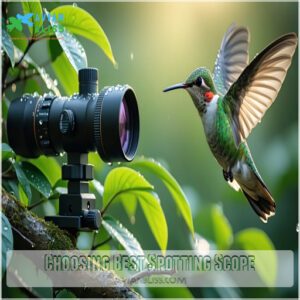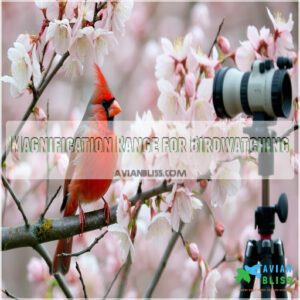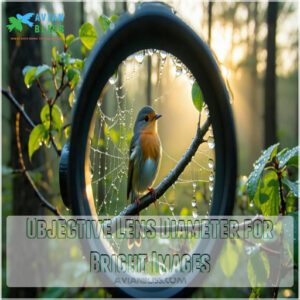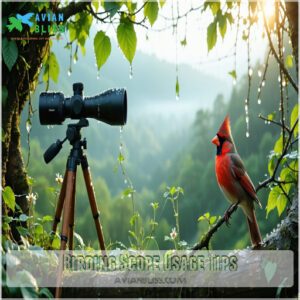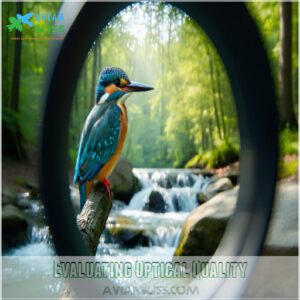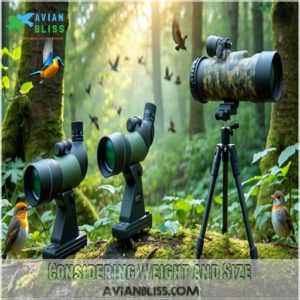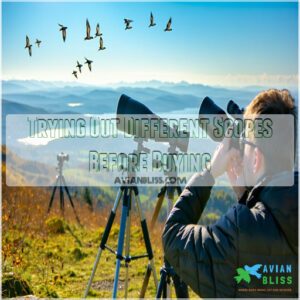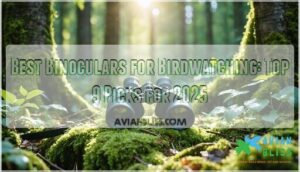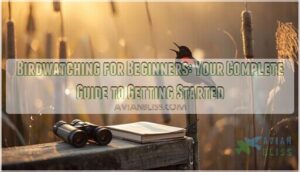This site is supported by our readers. We may earn a commission, at no cost to you, if you purchase through links.

For stunning detail, go for extra-low dispersion (ED) glass or HD lenses to avoid fuzzy views.
Magnification between 20-60x works great—don’t overdo it, though, because high zoom can make things shaky.
An 80-85mm objective lens brings in more light, which is perfect for early mornings or cloudy days.
If you’re budget-conscious, models like the Vortex Razor HD are stellar without breaking the bank.
Prefer premium? Swarovski and Zeiss offer unmatched clarity.
A solid scope makes birdwatching a whole new ballgame, with extra-low dispersion (ED) glass providing clear views and HD lenses enhancing the experience.
Keep reading!
Table Of Contents
- Key Takeaways
- Choosing Best Spotting Scope
- Top 10 Birding Scopes
- 1. Swarovski ATX STX 85mm Modular Objective Lens
- 2. Zeiss Victory Vario Harpia Spotting Scope Eyepiece
- 3. Swarovski ATS 80 HD 20 60x Spotting Scope
- 4. Swarovski ATS 80 HD Spotting Scope Body
- 5. ZEISS Conquest Gavia 85 Spotting Scope 30 60x
- 6. Vortex Razor HD 85mm Angled Spotting Scope
- 7. Vortex Razor HD 85mm Spotting Scope
- 8. Nikon Monarch 82ED A Fieldscope Spotting Scope
- 9. Celestron Regal M2 80ED Spotting Scope
- 10. Nikon Prostaff 5 82mm Angled Spotting Scope
- Key Features for Birding
- Birding Scope Usage Tips
- Buying Guide for Birders
- Frequently Asked Questions (FAQs)
- Are spotting scopes good for birding?
- What is the best birding scope?
- What size spotting scope do you need for birding?
- Which spotting scope is best?
- What is the best spotting scope for wildlife?
- What is the best birding spotting scope?
- What magnification spotting scope for bird watching?
- Is a straight or angled scope better for birding?
- What magnification is best for bird watching?
- How do spotting scopes compare to binoculars?
- Conclusion
Key Takeaways
- Look for scopes with ED or HD glass to get sharp, clear images without color distortion.
- An 80-85mm objective lens is ideal for bright views, especially in low-light conditions.
- Choose a 20-60x magnification range for versatile zooming and crisp details without shaking.
- Opt for durable, waterproof designs to handle outdoor conditions comfortably.
Choosing Best Spotting Scope
You’ll discover how to pick the perfect spotting scope for birding without breaking the bank, from budget-friendly options under $500 to premium scopes that’ll make you feel like you’ve got eagle vision.
Whether you’re a newbie birder or a seasoned pro, we’ll help you match your needs with the right scope features, including magnification power and lens quality that’ll bring those distant birds up close and personal.
Consider Price Range
When picking the best spotting scope, price matters.
Budget options under $500 suit beginners, while $1,000-$2,000 scopes offer premium perks without breaking the bank.
For best viewing, consider lens quality and coatings.
Platinum-class scopes exceed $2,500, delivering unmatched clarity.
Compare price ranges carefully—higher cost doesn’t always mean better value.
Affordable spotting scopes often pack great features, so weigh cost factors against your needs for the perfect balance!
Evaluate Magnification Power
When choosing a scope, magnification power matters.
A good Power Range balances detail and stability.
Spotting scopes offer variable magnification levels for birding.
Look for these:
- Higher Magnification Levels (30-60x): Great for far-off birds.
- Zoom Control: Smooth switching is essential.
- Focus Adjustment: Precise tweaks avoid blurry views.
- Optical Clarity: Higher power scopes need clear lenses.
Adjust wisely—too much zoom, and stability suffers!
Assess Zoom Lens Quality
Not all zoom lenses are created equal.
A good zoom lens balances Lens Clarity, Zoom Precision, and Focus Speed.
Beware of losing sharpness at higher magnification.
Higher-end scopes have Optical Coating for better Image Stabilization and optical quality.
Audubon provides expert scope guidance for birdwatching.
Here’s a comparison:
| Feature | Budget Scopes | Mid-Range Scopes | Premium Scopes |
|---|---|---|---|
| Lens Clarity | Moderate | Sharp | Crystal Clear |
| Focus Speed | Slow | Medium | Lightning Fast |
| Zoom Precision | Decent | Excellent | Flawless |
| Image Stabilization | Limited | Solid | Top-tier |
| Price |
Note: The price column is empty in the original table, so it remains empty here.
Check Glass Quality
Glass quality makes all the difference in spotting scopes.
High-quality optics use ED or HD glass for sharpness and color fidelity. Consider available HD spotting scope glass products.
Look for Glass Coating to enhance light transmission and reduce glare. A high Abbe Number guarantees minimal chromatic aberration, improving Optical Clarity.
Great materials, like premium Lens Material, boost image quality and the overall viewing experience.
Determine Light Gathering Capacity
Great image quality relies on the scope’s light gathering capacity.
Bigger objective lenses improve brightness but add weight. Better coatings and high-quality optics boost light transmission for sharper views.
Consider a brightest spotting scope purchase for ideal birdwatching.
- Lens Size: Go for 80mm+ for brighter images.
- Optical Density: Reduces glare, enhances detail.
- Aperture Control: Maximizes low-light performance.
- Magnification Power: Balance clarity with brightness.
Happy birding!
Top 10 Birding Scopes
You want the best spotting scope for birding, but sorting through all the options can feel overwhelming.
Don’t worry, we’ve rounded up the top 10 picks for 2025 to make your choice easier.
1. Swarovski ATX STX 85mm Modular Objective Lens
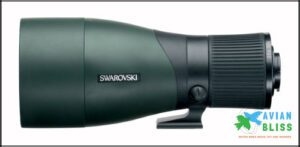
The Swarovski ATX STX 85mm Modular Objective Lens is a beast for birding.
Its 85mm lens brings stellar brightness and sharpness, even in low light. The HD fluoride glass provides incredible clarity, so no detail goes unnoticed.
It’s versatile with a modular design, fitting different eyepieces for adaptability. While the magnification changer can feel stiff, the focus ring is buttery smooth.
Yes, it’s pricey—around $4,000—but it’s worth every penny if you’re serious about birdwatching. This one’s built to impress!
Best For: Serious birdwatchers who want top-notch optical performance and adaptability for various viewing situations.
- Outstanding brightness and clarity, even in low light.
- Modular design for compatibility with different eyepieces.
- Durable construction with HD fluoride glass for superior image quality.
- Expensive at around $4,000.
- Stiff magnification changer can be challenging to use.
- Limited tripod foot compatibility without specific adaptors.
2. Zeiss Victory Vario Harpia Spotting Scope Eyepiece
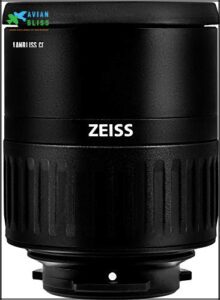
Zeiss Victory Vario Harpia eyepiece is a powerhouse for birders.
It offers a sharp, clear view across its 72° wide zoom range, letting you spot distant details effortlessly.
With premium fluoride glass and T and LotuTec coatings, you won’t battle glare or chromatic aberration.
Waterproof, fogproof, and lightweight, it’s perfect for wetland adventures or backpacking trips.
The dual magnification options (22-65x or 23-70x) give versatility for various species.
It’s durable, reliable, and designed for top-tier birdwatching.
Best For: Dedicated birdwatchers seeking sharp clarity, versatile magnification, and a durable design for outdoor adventures.
- Crystal-clear images with wide 72° zoom range.
- Waterproof, fogproof, and lightweight for easy transport.
- Premium fluoride glass for glare-free, high-contrast views.
- High cost compared to other scopes.
- Limited to Zeiss Victory Harpia spotting scopes.
- May require a sturdy tripod for optimal use.
3. Swarovski ATS 80 HD 20 60x Spotting Scope
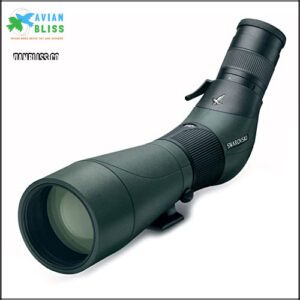
If you’re ready to make birdwatching a dream, this scope’s got your back.
The Swarovski ATS 80 HD boasts crystal-clear optics and a 20–60x zoom, perfect for distant birds.
Its fluoride-containing HD lenses deliver sharp, true-to-life images, even in low light.
It’s fully waterproof and lightweight, so you can take it anywhere.
The ergonomic design makes long birding sessions a breeze.
Sure, it’s pricey, but exceptional durability and performance justify the investment.
It’s like having a front-row seat to nature’s little dramas.
Best For: Nature enthusiasts and birdwatchers seeking premium image clarity, durability, and performance in all conditions.
- Crystal-clear optics with fluoride-containing HD lenses for sharp, color-accurate images.
- Lightweight and ergonomic design for comfort during long sessions.
- Fully waterproof and durable, suitable for harsh outdoor conditions.
- High price point compared to similar models.
- Limited portability due to its larger size.
- Requires a sturdy tripod for optimal use at higher magnifications.
4. Swarovski ATS 80 HD Spotting Scope Body
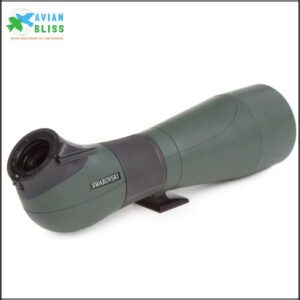
If you’re after a premium birding scope, the ATS 80 HD body’s hard to beat.
It delivers stunning image clarity, thanks to HD optics that cut down on color fringing.
A comprehensive bird watching equipment guide can help you choose the right tools.
Its rugged aluminum build, coated for durability, stands up to tough weather. You’ll appreciate the easy-to-clean lenses with nonstick SWAROCLEAN coating—great for outdoor adventures.
While it’s sold without an eyepiece, the modular design lets you customize your setup. Lightweight and sharp, it’s a go-to choice for serious birdwatchers. Fancy yet functional!
Best For: Serious birdwatchers looking for a premium, customizable scope with outstanding image quality.
- HD optics eliminate color fringing for sharp, clear images.
- Durable aluminum build with a nonstick lens coating for easy cleaning.
- Modular design allows customization with compatible eyepieces.
- Eyepiece sold separately, adding to overall cost.
- Higher price point compared to similar spotting scopes.
- Limited edge-to-edge clarity at extreme magnifications.
5. ZEISS Conquest Gavia 85 Spotting Scope 30 60x
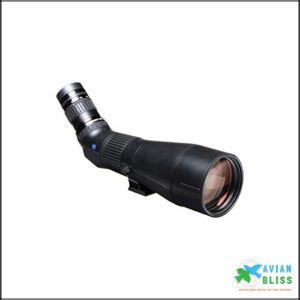
If you’re serious about birding, the ZEISS Conquest Gavia 85 is like a trusty trail companion.
Its 30-60x zoom delivers sharp, clear views, even at long distances.
The lightweight build makes it great for hikes, while the durable rubber coating handles tough weather like a champ.
The built-in sunshade keeps glare at bay for better visibility.
Pair it with a solid tripod, and you’ve got a combo perfect for spotting hawks or distant landscapes.
It’s reliable, durable, and simply worth considering.
Best For: Birdwatchers, nature enthusiasts, and outdoor adventurers who value high image quality and portability.
- Exceptional clarity and sharp image quality at all zoom levels.
- Compact and lightweight design, perfect for travel and hikes.
- Durable rubber coating for tough weather conditions.
- Lens arrived with shipping issues, including a fingerprint and detachment.
- No owner’s manual included, only a user card.
- Requires a solid tripod for optimal use.
6. Vortex Razor HD 85mm Angled Spotting Scope
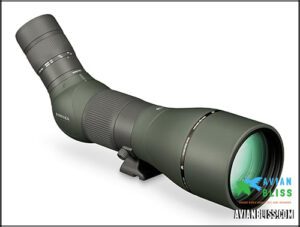
The Vortex Razor HD 85mm angled spotting scope is a birding powerhouse.
With 27-60x magnification and exceptional glass quality, it delivers stunningly sharp, bright images.
You’ll love its weatherproof build—it’s O-ring sealed, argon-purged, and tough as nails.
The dual focus knobs are a delight, making fine adjustments a breeze.
It’s lightweight for its size, portable, and pairs perfectly with a sturdy tripod.
Plus, the VIP lifetime warranty has your back, which is like having insurance for your birding adventures.
A worthy investment for serious nature lovers!
Best For: Serious birders and outdoor enthusiasts looking for premium optical performance and durability.
- Exceptional glass quality for sharp, bright images.
- Weatherproof and rugged design for outdoor use.
- VIP lifetime warranty for peace of mind.
- Requires a sturdy tripod for optimal performance.
- Eyecup design may not be ideal for glasses wearers.
- Front optic cover loop may not stay secure.
7. Vortex Razor HD 85mm Spotting Scope
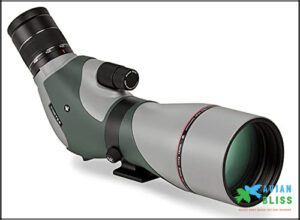
For birders who like crisp views, the Vortex Razor HD 85mm spotting scope doesn’t disappoint.
Its high-density, scratch-resistant glass gives you bright, sharp images, even at higher magnifications.
The rugged magnesium body, sealed against water and fog, holds up well in wild weather.
It’s lightweight and compatible with digiscoping, so snapping photos with your phone is a breeze.
While the focus knob might feel loose when zoomed in, the lifetime warranty adds peace of mind.
It’s perfect for birding or archery!
Best For: Birders, archers, or photographers looking for crisp image quality and durability in various weather conditions.
- High-density glass for bright, sharp images.
- Rugged, waterproof, and fogproof magnesium body.
- Compatible with digiscoping for easy photography.
- Focus knob may feel loose at high magnification.
- Slight image shake at maximum zoom.
- Higher price point compared to similar models.
8. Nikon Monarch 82ED A Fieldscope Spotting Scope
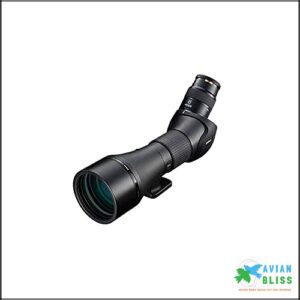
If you’re after crisp, bright images for birdwatching, the Nikon Monarch 82ED Fieldscope is an excellent pick.
Its ED glass reduces color fringing, giving you a true-to-life view.
The sturdy build handles rough weather, while the angled design provides hours of comfortable viewing.
While the zoom and focus rings are smooth, they can feel slightly unstable at times, so pair it with a quality tripod for less shake.
It’s perfect for detailed birdwatching or even some impromptu stargazing on clear nights!
Best For: Birdwatchers and stargazers seeking sharp, vibrant images and durable construction.
- ED glass minimizes color fringing for natural color accuracy.
- Angled body design for comfortable long observation sessions.
- Weather-resistant build for versatile outdoor use.
- Requires a high-quality tripod for stability at higher magnifications.
- Zoom and focus rings may feel slightly unstable.
- Learning curve for beginners transitioning from binoculars.
9. Celestron Regal M2 80ED Spotting Scope
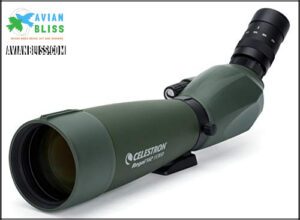
The Celestron Regal M2 80ED is like having a front-row seat to nature.
Its ED glass minimizes color distortion, so bird colors pop vividly. The 20-60x zoom range lets you switch smoothly between wide views and fine details.
It’s built tough with a magnesium alloy body but remains portable for outdoor treks. You’ll love the dual-focus system for quick adjustments and its tripod mount for flexibility.
It’s perfect for birdwatching, plus it supports digiscoping for capturing memories. A solid all-rounder!
Best For: Outdoor enthusiasts and birdwatchers seeking clear, vibrant images and versatile magnification options.
- ED glass minimizes chromatic aberration for true-to-life colors.
- Dual-focus system enables quick and precise adjustments.
- Durable magnesium alloy body with flexible tripod mount.
- Heavy for extended carrying during long treks.
- Focus mechanism location may require adjustment time for new users.
- Field of view narrower than higher-priced competitors.
10. Nikon Prostaff 5 82mm Angled Spotting Scope
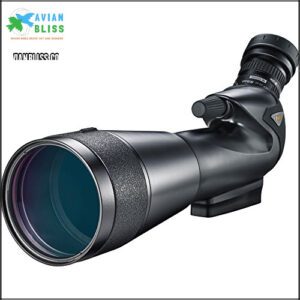
Think of the Nikon Prostaff 5 82mm Angled Spotting Scope as your reliable birdwatching companion.
Its 20-60x zoom delivers crisp, bright images, perfect for spotting distant birds.
The angled design keeps your neck happy during long sessions, while the lightweight build makes it easy to carry.
It’s waterproof and fog-proof, great for unpredictable weather.
With a sliding sunshade, glare won’t ruin your view.
Whether you’re a beginner or seasoned birder, this scope combines performance and value seamlessly, making every outing a joy.
Best For: Birdwatchers looking for a lightweight, weather-resistant, and versatile scope with excellent zoom and image clarity.
- Bright, high-contrast images with 20-60x zoom.
- Lightweight and portable with an angled design for comfort.
- Waterproof and fog-proof construction for all-weather use.
- Limited to 82mm objective lens; larger sizes may gather more light.
- Prone to water ingress despite waterproof claims.
- Plastic construction might feel less durable to some users.
Key Features for Birding
You’ll want a spotting scope that’s tough enough for the outdoors but lightweight enough to carry all day.
Look for features like great magnification, a bright lens, and an angled design—it’s like getting a front-row seat to nature’s show.
Magnification Range for Birdwatching
When choosing the best spotting scope, magnification power matters.
A zoom spotting scope with a range of 20x to 60x offers the perfect boost for bird viewing, letting you spot details binoculars miss.
Adjust the scope to balance image clarity and stability.
- 20x: Wider view, easier tracking.
- 40x: Ideal balance for image clarity.
- 60x: High-power scope for distant birds.
Objective Lens Diameter for Bright Images
When evaluating image brightness, lens size plays a key role.
A larger objective lens enhances light collection, particularly in low-light conditions.
If you’re after superior optical quality and scope resolution, seek out lenses measuring 80mm or more.
These lenses improve image clarity, even at higher magnification levels, and deliver sharp details, allowing you to appreciate every feather and movement effortlessly, which is a result of high-quality optics.
Angled Body Design for Comfort
An angled spotting scope is a game-changer for comfort.
Its angled body lets you stay relaxed during long birding sessions, reducing neck strain.
A detailed bird watching equipment guide offers valuable insights for both beginners and experienced birders.
Combine ergonomic handles with adjustable body angles for smooth positioning, and eye relief is better too, especially for glasses.
Scope stability improves since you can adjust height easily—a must for clear views in every spotting scope review, making it a crucial aspect of a spotting scope.
Durability and Weather Resistance
When you’re out birding, your waterproof spotting scope needs to handle the elements.
A durable, weatherproof design can shrug off rain, fog, and rough handling.
Look for:
- Waterproof design to guard against rain.
- Fogproof tech for clear views in humidity.
- Shock resistance to survive drops.
- Weather sealing for dirt and grime.
- Rust protection for long-lasting use.
Warranty and Customer Support
A good spotting scope needs stellar support services.
A fast claim process or solid customer care can save headaches.
Premium spotting scope brands often deliver flexible repair options and lenient return policies.
Here’s a quick comparison:
| Feature | Top Brands | Budget Scopes | What to Expect |
|---|---|---|---|
| Warranty Length | Lifetime | 2-5 Years | More peace of mind |
| Customer Care Quality | Expert Help | Limited Assistance | Faster issue resolution |
| Repair Options | Extensive | Basic Repairs | Better durability |
| Return Policy | Hassle-Free | Strict Conditions | Easier exchanges/returns |
Pick a scope, avoid warranty woes!
Birding Scope Usage Tips
Using a spotting scope for birding isn’t hard, but getting the best view takes a little practice and patience.
From setting up on uneven ground to capturing a bird’s finest details, a few simple tricks can make your birdwatching sharper and far more fun.
Setting Up Your Spotting Scope
Start by choosing a sturdy tripod with height adjustability for stability.
Mount your spotting scope securely, making sure the focus mechanism moves smoothly. Adjust the eyepiece and set eye relief for clear viewing comfort.
Scope calibration is key—check alignment with a distant target. Practice quick focus techniques for sharp images.
Digiscoping? Make sure everything’s snug to avoid camera shake.
Using Your Scope for Birdwatching
Once your bird watching scope is ready, bring it to your eye and let nature surprise you.
Look for Bird Behavior—watch how they perch, preen, or soar.
Keep Scope Handling smooth for steady views. Scope Accessories, like a sturdy tripod, help.
Clean lenses regularly for crisp images. A best spotting scope reveals details binoculars just can’t match!
Observing Birds in Open Spaces
Scouting open spaces like wetlands or grasslands gives a front-row seat to bird behavior.
Use your birding scope to track wildlife subtly, respecting their habitat. A wide field of view captures distant details while maintaining clarity, even in low light.
The best spotting scope balances portability and power, perfect for immersive wildlife viewing—just pack light, and don’t forget snacks, which is crucial for an enjoyable experience in wildlife viewing.
Capturing Fine Details With Your Scope
How do you capture every feather and fine detail? First, adjust the focus mechanism smoothly to avoid blur.
Use scope calibration for sharp image quality at high magnification power. A complete bird watching equipment guide offers valuable insights for birders of all levels.
Protect clarity with quality lens coatings. Finally, don’t forget eye relief—it’s essential for comfort and steadiness, especially with a high power scope. Fine details? Dialed in!
- Adjust focus mechanism.
- Calibrate for clarity.
- Choose coated lenses.
- Maintain proper eye relief.
Tips for Digiscoping and Photography
Digiscoping turns any bird watching scope into a photo lens powerhouse.
Use a tripod for image stabilization, and calibrate your lens carefully. Smartphone adapters? A lifesaver!
Check camera settings like burst mode for action shots. Photo editing apps fix light issues later.
Investing in a digiscoping scope? Read a spotting scope review or test top spotting scopes in-store.
| Tip | Why It’s Important |
|---|---|
| Tripod Usage | Stabilizes your setup for sharper images. |
| Camera Settings | Burst mode captures fast bird movements. |
| Lens Calibration | Guarantees crisp, clear focus. |
| Photo Editing | Fixes lighting and color issues post-shot. |
| Digiscoping Adapters | Simplifies alignment and prevents vignetting. |
Buying Guide for Birders
Choosing the right spotting scope doesn’t have to be overwhelming if you know what to look for.
With a bit of planning, you can find one that fits your birdwatching needs, whether it’s crisp optics or a lightweight design for long hikes.
Evaluating Optical Quality
Great optical quality really shows when you’re watching birds in action.
Look for sharp details and vibrant colors.
Check these:
- Lens Clarity: Clearer lenses mean better views.
- Optical Coatings: Boosts light transmission.
- Image Sharpness: Sharp images make spotting easier.
- Color Fidelity: True-to-life hues matter.
- Light Transmission: Helps in dim settings.
It’s like seeing nature in HD!
Considering Weight and Size
When picking a spotting scope, size and weight matter more than you’d think.
A lightweight spotting scope is easier to carry, especially on long hikes. Compact designs are great for quick setups.
Here’s a size comparison:
| Scope Type | Weight | Portability Matters |
|---|---|---|
| Compact Spotting | Under 2 lbs | Ideal for travel |
| Mid-Range Scope | 2–4 lbs | Balances size and performance |
| High-Power Scope | Over 4 lbs | Best for stationary birding |
Choose wisely!
Assessing Company Reputation and Service
When choosing the best spotting scope, trust matters.
Look for brands with strong customer support and great service quality.
Scan company reviews for real insights, and check how they handle warranty claims.
A good bird watching scope should feel backed by its maker.
Reliable companies build brand loyalty, plus offer spotting scope accessories for added value!
Comparing Prices and Value for Money
When comparing prices, focus on value for money.
Budget options under $500 offer decent performance but might miss premium features.
Mid-range scopes balance cost and quality.
High-priced models like Swarovski deliver unmatched image clarity but may stretch your budget.
A good price comparison helps you pick an affordable scope that meets your needs without sacrifices.
It’s all about cost benefits!
Trying Out Different Scopes Before Buying
Before buying the best spotting scope, test it hands-on. Here’s how:
- Visit stores for direct scope comparison; bring birding essentials.
- Try optical testing outdoors; focus on details.
- Attend birdwatching events for field trials with top spotting scopes.
- Read user reviews; match needs with others’ experiences.
Finding a spotting scope should feel like discovering your perfect wingman! It’s about finding the right tool that enhances your birdwatching experience, making it more enjoyable and successful.
Frequently Asked Questions (FAQs)
Are spotting scopes good for birding?
Ever tried spotting distant birds with just binoculars?
Spotting scopes are perfect for birding, offering sharper details, better zoom, and clear views in open spaces.
They’re like having eagle eyes—ideal for serious bird enthusiasts who want to experience birding with clear views.
What is the best birding scope?
The Swarovski ATX 25-60×85 is a top pick for birding.
It delivers breathtaking clarity, a durable build, and smooth zooming.
Sure, it’s pricey, but for unmatched performance, it’s worth every penny.
What size spotting scope do you need for birding?
You’d be surprised, but the sweet spot for birding scopes is 20-60x magnification with an 80-85mm objective lens.
It’s bright, crisp, and perfect for spotting those feathered friends, even in dim light!
Which spotting scope is best?
For superior quality, the Swarovski ATS 80 HD is your best bet—crystal-clear images, top durability, and lightweight.
If you’re budget-conscious, the Vortex Viper HD delivers stunning performance at a fraction of the price.
What is the best spotting scope for wildlife?
Picking the best wildlife spotting scope is like finding the perfect hiking boots—comfort and performance matter.
The Swarovski ATX 85 delivers stunning clarity, durability, and brightness, while the Vortex Razor HD offers superior value and dependability.
What is the best birding spotting scope?
For birding, you’ll love the Swarovski ATS 80 HD.
It’s lightweight, weatherproof, and delivers razor-sharp images.
If budget’s tighter, the Vortex Viper HD 20-60×80 offers fantastic clarity and durability without breaking the bank.
What magnification spotting scope for bird watching?
For birdwatching, a spotting scope with 20-60x magnification is ideal.
It gives you versatility for long-distance views while keeping details sharp.
Too much zoom, though, can make the image shaky and dim.
Is a straight or angled scope better for birding?
An angled scope works great for long birding sessions, especially with groups or uneven terrain.
It’s comfier for taller folks, while straight scopes are better for quick views or if you’re tracking birds in flight.
What magnification is best for bird watching?
Imagine spotting a rare hawk from 800 yards.
A 20-60x magnification range works best for birdwatching, offering flexibility.
Stick to 20-40x for sharper images; higher magnification blurs details unless you’ve got a rock-solid tripod.
How do spotting scopes compare to binoculars?
Spotting scopes outshine binoculars for long-distance detail, offering higher magnification and better brightness.
They’re bulkier but perfect for wildlife observation.
Binoculars are lighter, more portable, and great for quick scans.
It’s like comparing a telescope to sunglasses, which highlights the significant difference in long-distance detail.
Conclusion
Picture standing in a quiet meadow, your spotting scope revealing the vibrant feathers of a perched bird, crystal clear.
Choosing the best spotting scope for birds depends on your priorities—budget, clarity, and comfort. Whether you pick a premium Swarovski or a budget-friendly Vortex Razor HD, focus on high-quality ED glass and a smooth zoom.
Go for an 80-85mm lens for bright images, even in dim light, to elevate your birdwatching game with the best possible view, using high-quality equipment.
Ready to elevate your birdwatching game? Start exploring today!
- https://www.audubon.org/gear/scope-guide
- https://www.smokymountainstarlight.com/easy-guide-to-spotting-scopes
- https://www.cloudynights.com/BVD/The-Ultimate-Birding-Scope.php
- https://binocularbase.com/spotting-scopes-by-distance/
- https://tractoptics.com/blog/the-beginners-guide-to-using-a-spotting-scope/

